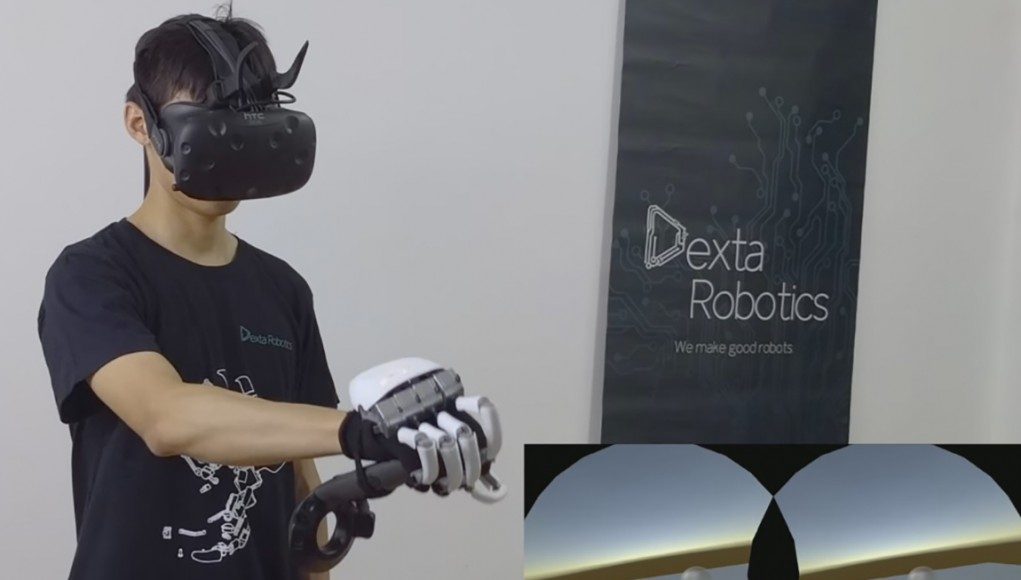Dexta’s exoskeleton glove is a haptic input system which is designed to give users a sense of touch in VR. These new videos which show how the company’s ‘Dextarity Interaction Engine’ gives developers the tools they need to get the virtual world to push back.
The subtleties of a our sense of touch is taken for granted most of the time, you’re unlikely to have given much thought as to just how much information can be passed on through infinitely subtle interactions our fingers and hands have with real world objections. Dexta’s Dexmo exoskeleton gloves are designed to emulate those subtleties, to help add not only immersion to virtual reality experiences, but to give the user that naturalistic, human, tactile guiding force we take for granted in reality, but miss horribly when it’s gone in VR.
We wrote recently on Dexmo’s exoskeleton gloves, quizzing Dexta Robotic’s CEO Aler Gu on what makes Dexmo tick from a hardware perspective, briefly touching upon development APIs. Now, Dexta have released two new videos which demonstrate what they’re calling ‘Dextarity Interaction Engine’ (DexIE for short), an extended set of developers tools and algorithms which define a sort of haptic language for which devs can communicate events, interactions and help to build a virtual physical interface of sorts.
One of the bigger issues when your mind is immersed in a virtual space, and with your hands actions faithfully reproduced, it’s jarring when you’re virtual avatar passes through objects that have no physicality on the virtual plane. DexIE provides options for developers to give solidity to those objects, by ‘preventing’ your fingers physical position penetrating the mesh of a polygonal object.
Dexta CEO Aler Gu, speaking to us via email says “The guiding principle in hand interaction is that the mesh of hands and objects shouldn’t penetrate each other. Once our brain observe that, it will immediately know it’s not real. And that really breaks the immersion,” adding, “There are also a lot of the problems which only appear when you have the right hardware for it. For example, when you are using the Vive controller to pick something up, there is no physics. You are basically ‘sticking’ the object using 2 sets of 3d coordinates.”
With Dexmo however, Dexta thinks their device makes all the difference, Gu tells me that “There are multiple contact points that actually performs physical interaction with 3d objects, which is why “switch between hands interaction” is actually very difficult to implement. Fortunately our engineers found a way to solve that problem after all. We also have an “Object selection indicator” and “Invalid interaction Indicator” to help further improve the user experience.”
Dexmo gloves are, naturally, limited in that they can only enact opposing force to your hand’s digits and only within a certain range. But Dexta believe that their “complex algorithms” go a long way to give VR users that instant hand-object collision notification.
Elsewhere the haptic events are more subtle; Emulating the physical ‘click’ of a button or switch, or conveying the weight of an object playfully flipped by your fingers for example. Then there’s the downright useful tactile sizing of objects interacted with, for example picking up a screw, sensing its dimensions before fitting it to a nearby table.
Gu tells us what they aimed to convey with the above video:
This is a parallel comparison between Vive and Dexmo for certain common tasks in VR. The user is requested to pull a lever, turn a knob, and press some buttons. Dexmo can simulate the physical presence of the lever, knob and the different layers of stiffness for the buttons. When the force feedback is combined with the sound, graphics, it really leaps to the next level of immersion.
We have had a total of 40 volunteers trying out this demo, and 100% of them agreed that Dexmo provides a more immersive VR experience. Another thing we have observed during our user studies is that, when people are using the Vive, we have to teach them how to use Vive controllers to operate the widgets; With Dexmo, it is very natural and intuitive. People reach out their hands and it just works. we don’t have to say anything. So that was a really encouraging feedback for us.
The demo you are seeing in the video is actually made by one of our software engineers who spent only 3 month playing with Unity. You can imagine the magical experience that developers with 5 years of experiences can pull out with this Device!
It’s undeniably all very cool. However we still have questions over cost, tracking and availability to market. Some which we touched upon in our recent interview with Aler Gu. It’s also another example of a peripheral that will require specific software integration in order to reach its potential, which is why these videos are important of course – proving to potential developer partners that Dexta have already done a lot of hard work for them.








